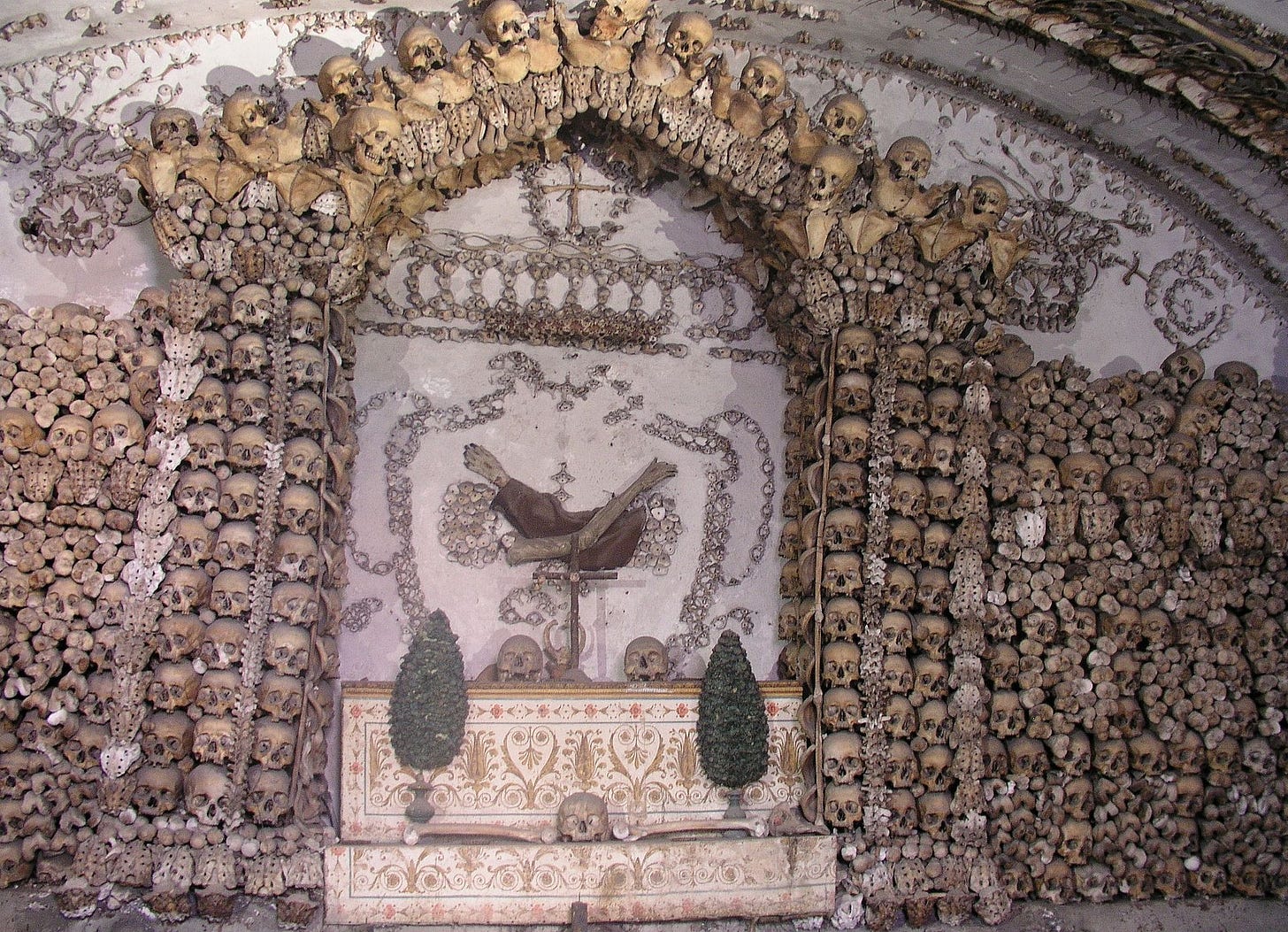Hey Everybody,
Today, is the feast of St. Faustina Kowalska, the saint of divine mercy, and this is The Tuesday Pillar Post.
The News
— The German “Synodal Path” had a three-day meeting in Frankfurt over the weekend, that turned out to be surprisingly disorganized, given that it was planned, administered, and populated by German bureaucrats.
In fact, the meeting suffered from a kind of proceduralist traffic jam — so many delegates at the meeting made motions about procedure that dealing with them cut rather substantially into debate on matters of substance.
There may be an object lesson there, but I’ll leave it for you to decide.
In the meantime, the delegates voted on measures concerning evangelization, the priesthood, marriage, and, of course, matters of sex. But again, the rules and procedures of the “Synodal Path” are complex enough that even folks in the room weren’t always sure how the votes were going. So we broke down for you the key points of what happened, what it actually meant, and why that matters.
To help you keep track of all stops along the “Synodal Path,” The Pillar brings you 🎈5 luftballons from Frankfurt.
— Saturday was the Feast of the Guardian Angels. In The Pillar’s newsroom, we found ourselves discussing last week what we actually believe about guardian angels, and why we believe it. There is a lot of legend out there about “our angels,” and not much sparkling clarity on what the Church actually teaches about our angelic guardians.
So we spoke with several theologians, who explained what the Church has taught about guardian angels, and why. One even tackled a topic most controversial in some Catholic circles: “Should you name your guardian angel?”
“Are guardian angels really a thing? (And how do we know?)”
— The Catholic Church in Australia began a plenary council on Sunday — an actually legislative affair that aims to discern direction and priorities for the Church Down Under, and then set policy.
We’ll talk with voices inside and outside the council as it takes place — we kicked that off by talking with Daniel Ang, director of the Archdiocese of Sydney’s Centre for Evangelisation, and a theological adviser to plenary council delegates.
— The Archdiocese of Cincinnati announced on Friday a new restructuring initiative that could eventually close 70% of parishes in the archdiocese. Other dioceses have already launched similar initiatives over the years, but on Friday I offered an analysis on why the “Cincinnati model” could become the standardized model for parish closures and mergers across the United States.
Cincinnati Archbishop Dennis Schnurr’s “decision seems motivated by two realities. The first is an increased awareness that the multi-parish, circuit-riding, on-the-road lifestyle of many young priests leads eventually to burnout, which is sometimes accompanied by “liability events,” as any number of unhealthy or unholy lifestyle choices might be termed. The second is an understanding that the kind of wholesale American institutional disaffiliation experienced in recent years isn’t going away, and the belief that it will not be countered by a commitment to maintaining an outsized institutional footprint at all costs.”
…
The archbishop’s plan, if it will work, will require careful management and ongoing attention. It depends upon actually doing the consultation it promises, and upon the buy-in of priests. And if priests initially say they’ve not been heard, or that the lay consultation process is not getting good reception in local parishes, Schnurr, known widely as a “process guy,” will need to call the required audibles to make things work.
— The U.S. bishops’ conference in June approved the drafting of a new pastoral planning statement on Native American ministry in the U.S.
We wondered what Native American Catholicism looks like today, and what Native American Catholic leaders think the future should look like.
The Pillar asked freelance reporter Joe Slama to get on the road, and on the phone, to talk with Native American Catholic leaders across the country, about the past, present, and future of Catholic life for Native American Catholics. Joe wrote a three-part series that shouldn’t be missed.
And then you can read part 2 here.
Please do read them — they’re the kind of work The Pillar is proud to produce, and Slama’s reporting offers insight into the Catholic life of more than 700,000 Native American Catholics in the U.S.
‘I’ll put the system on trial’
Ten Vatican criminal defendants, including Cardinal Angelo Becciu, are waiting for a ruling Tuesday, after a very unusual hearing in the Vatican financial trial.
During the hearing, Vatican prosecutors offered to address procedural problems in their criminal case by effectively restarting their investigation: Pausing an active trial to question suspects and witnesses again.
A ruling on the offer is expected Wednesday.
The offer is the latest turn in the roller-coaster of the Vatican financial scandal.
Since the criminal trial began formally in July, defense attorneys have alleged that prosecutors aren’t following the rules of evidence, aren’t allowing them to access necessary material to prepare for trial, and aren’t listening to court orders about evidence sharing.
Prosecutors have said they’re doing their best to prepare a serious trial in difficult circumstances, and with limited resources. The trial alleges that Vatican officials, including Becciu, abused their offices, amid a nest of corrupt transactions in which contractors, brokers, and officials were engaged in extortion and money laundering.
But while evidence reported by The Pillar makes clear that there are obvious potential crimes involved in the financial affairs of the Vatican Secretariat of State, defense lawyers aren’t the only ones to criticize Vatican prosecutors.
A June report from Moneyval, the European anti-money laundering watchdog, said the Vatican’s prosecution team lacked practical experience, specialized law enforcement assistance, and the financial wherewithal to conduct the kind of prosecution it was aiming for.
In March, a British judge said Vatican prosecutors had made a series of errors in their efforts to freeze the assets of indicted businessman Guinluigi Torzi, and had failed to produce evidence to support their motions.
In short, here’s where things stand:
There is a well-documented set of problems connected to the financial dealings of the Secretariat of State, and, according to prosecutors, plenty of blame to go around.
Prosecutors cast a very big net, indicted a lot of people connected to the scandal, and scored big when they saw a cardinal indicted over financial crimes for the first time in several hundred years. But since then, they’ve started wobbling — they’re criticized for their handling of evidence by legal experts in several countries. Now, their case seems to hang in the balance — if judges send the whole thing back to investigations, it could fizzle out for lack of resources.
Becciu, who insists he is absolutely innocent, may well see any attempt at prosecution delayed indefinitely.
Becciu, Torzi, Marogna, et al, have managed to put the system on trial — and if the case ends up falling apart, they may have beaten it.
Fille aînée de l'Église
In France Tuesday, an independent commission published a report on decades of clerical sexual abuse in the Catholic Church in France. The report was commissioned by the French bishops’ conference.
It depicts decades of sexual abuse and of cover-ups or insufficient responses by ecclesiastical officials. The report says that French bishops began to change their approaches in the 1990s, and that the Church since has done some work to change its culture and assure safe environments, but the report is nonetheless devastating.
The president of the French bishops’ conference has issued an apology, saying the report fills him with shame, horror, and determination to continue responding to clerical sexual abuse.
The details of the report are worth understanding. The commission which prepared the report identified 2,700 abuse victims between 1950 and 2020 through interviews, and another 4,800 through archival research. From there, it worked with a polling agency and the French Institute of Health and Medical Research to estimate a total number of potential clerical abuse victims between 1950 and 2020, which it placed at 216,000.
The commission estimated 3,200 clerical abusers committed those acts of abuse.
Devastating as the numbers are, it seems important to recognize them as estimates. In fact, as estimates they raise some important questions.
The French report suggests that somewhere between two and three percent of clerics may have committed acts of abuse — a number on par with studies in other countries. But the number of potential alleged victims per priest is comparatively off-the-charts.
The report estimates the abuse of 216,000 children by 3,200 clerics, over seven decades, which would suggest that each abusive cleric abused an average of 67.5 children.
In the United States, a 2004 study, the “John Jay Report,” found that 59% of accused priests were accused of a single allegation, and fewer than three percent of all priests accused of abuse are alleged to have had more than 10 victims. That is a marked difference from the numbers in the French report, which alleges an average of 67.5 victims per alleged abusive priest.
That difference could raise questions about the accuracy of the report. It might also suggest a more comprehensive study?
Why does the accuracy of the French estimates matter? Why does it merit further study? In the first place, the Church in France has said she wants to make restitution for victims, so having a realistic and accurate sense of the number of victims is important.
Also, the report’s estimated number of clerical abuse victims, 216,000, will be the number to make headlines, and be mentioned frequently in the ongoing fallout from the report in France.
If the methodology is off — if there are actually fewer victims, or actually more abusive priests — that should be understood, so that reform efforts can target the problem as it actually is, and as it actually was.
If the report’s methodology is correct, and abusive French clerics actually had many, many more victims than clerics in other places, the reasons for the disparity needs to be understood. That’s important for ensuring safe environments in the entire Church, as lessons will be learned in other countries from the situation in France.
—On a personal note, the publication of the French report seems an important time to mention some of the lessons I’ve learned personally from the sexual abuse crises of the past few years, and especially from my work as a journalist, interviewing and talking with clerical abuse victims across the country.
It was not too long ago that the publication of a report like today’s would have prompted a response from many that tried to put the problem of clerical sexual abuse in a broader cultural context — noting that abuse rates in other institutional settings are often higher than in the Church, and are usually highest in family settings. Such a response would also note that the Church has done more than many other institutions to reform and police itself.
Those things are true. But it’s also true that people have a different relationship to the Church than they do to other institutions — to summer camps or public schools.
The Church, not summer camp, offers the promise that we can be given freedom in Christ Jesus.
The Gospel asks for our trust — our faith, actually — and we tend to transfer that trust to the Gospel’s ministers. So while it is true that abuse exists at higher rates in other places, the Church is unique, because it’s the place we go for refuge, and healing, and freedom. We want to believe that the promise of the Gospel means that in the company of believers, we will be safe, and our relationships will be holy.
We do not want to believe that anyone might pervert, corrupt, or abuse the Cross as a cover for sin.
That’s why sin, and abuse especially, in the context of the Church feels especially shocking. Clerical abuse often takes from victims the freedom to place their trust in Jesus Christ and his Church, and makes that trust harder for the rest of us.
The Church’s institutional leaders have made efforts to address those issues. Not completely, not entirely, not even, in many cases, satisfactorily. But the reason why the scandal of abuse in the Church is especially acute, at least for many Catholics, is because we hope that the Church’s members, and especially her leaders, will live up to the promise of holiness offered by the Gospel of Jesus Christ.
And all of us should keep working to ensure that the Church’s structures, systems, and personnel are committed to their holiness, and to ours. The Gospel sets the bar, but it also offers the path to reform and renewal.
It’s a girl
Ed Condon, The Pillar’s cofounder and editor, along with Mrs. Condon, welcomed a baby girl, their first child, to the family early Saturday morning. Mom and baby are doing well, resting at home.
Their healthy and beautiful daughter, Mary, is named for the Blessed Virgin.
Ed told me this morning: “I know it’s a cliche, but I am really, really tired.” I suggested he get used to it.
On a more serious note, Ed asked me to thank you for your prayers, notes of support, Masses and rosaries offered for the family, and your support of The Pillar. So, on behalf of the Condons, thank you.
—
Yesterday was the feast of St. Francis of Assisi, and today some Franciscan communities remember the departed souls of the Seraphic Order (as they sometimes call themselves.)
If you know a deceased Franciscan, of any kind, who was a witness to the Gospel, today is a good day to pray for their eternal repose.
And actually, it’s always a good day to pray for all the holy souls in purgatory. Someone will eventually do the same for us.

—
As I mentioned, today is also the Feast of St. Faustina Kowalska.
If I’m being honest, I have no special devotion to St. Faustina, or dedication to the particular Divine Mercy devotions which began with her life and diary.
But one of the best confessions of my life was at the Shrine of Divine Mercy in Krakow, Poland. So today I am giving thanks to the priest who heard that confession, the shrine where it took place, and the saint who brought us there.
—
Thank you again for sharing The Tuesday Pillar Post:
And if you think our work is worth paying for (and it is) subscribe today, so Ed can buy his new baby daughter an appropriate watch (and pay the rent):
Please be assured of our prayers, and please keep praying for us. We need it.
Yours in Christ,
JD Flynn
editor-in-chief
The Pillar






